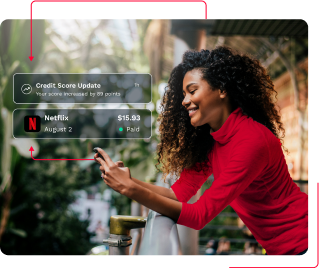
The past three Flex Your Finances “workouts” have covered setting goals, building a budget, and paying bills. Now, it’s time to put all of what we’ve learned together into a rock-solid financial routine!
Our daily habits make or break our success in many areas of our lives, including our personal finances. Here’s everything you need to know about creating a financial routine and sticking to it.
Before we dig in, let’s limber up our money muscles by learning how routines and habits impact our lives.
Maintaining a financial routine has the following benefits:
Clearly, a financial routine can be a huge benefit. But what can happen WITHOUT a financial routine?
Here are some negative consequences of NOT creating a financial routine:
A financial routine is a lot like a fitness routine. One trip to the gym isn’t going to give you bulging biceps…but if you go regularly, you’ll have a shot at the mega-muscles of your dreams. 💪💪
Creating a financial routine can seem like a daunting task, but it’s going to make your life so much easier in the long run!
Before you build your financial routine, take a moment to learn about what makes a good routine and get some tips to help you stay committed to your plan.
A solid financial routine includes the following elements:
Missing some of these elements? No worries, we’ll walk you through everything during the routine-building exercise.
If it was easy to stick to a routine, nobody would struggle to meet their goals! But the fact is, routines of any kind are tough.
Procrastination, unforeseen circumstances, schedule conflicts, or forgetfulness can cause even the most motivated people to stray from their plans.
Here are a few tricks to help you stick to your system:
While planning your routine, you might be tempted to aim for the stars. After all, you’re going for big changes, right? While it’s admirable to dream big, make sure your routine is REALISTIC for your lifestyle.
For example, if your day is filled with work, family obligations, kids’ sports, etc., you probably won’t be able to make a daily financial check-in work. But if you typically have Sunday afternoons free, designate one Sunday per month for financial fitness sessions.
This may go without saying, but routines should be…well…routine. Whatever financial routine you decide on, pick a regular cadence in terms of date and time. For example, plan to review your bills on the first Saturday of each month at 10am.
We’ve all tried to establish positive routines…like working out daily, journaling every morning, or learning a language. Which routines have “stuck” and which have fallen by the wayside? What are the differences between the two, in terms of motivation, logistics, level of difficulty, etc?
Analyzing these elements helps you figure out what motivates you as well as some warning signs to watch out for.
This might go without saying, but you’re MUCH more likely to stick to a routine if you enjoy doing it! You may be more motivated to go over your finances each month if you throw on some music and gather your favorite snacks to munch on while you work. If you budget with a partner, make it a date night and unwind together when you’re finished. There’s no rule that says financial routines have to be boring!
Along with making your financial routine fun, try treating yourself to a reward for sticking to your healthy habits. For example, if your financial planning habits helped you save $1000 over the quarter, set aside $100 for a self-care splurge or a frivolous purchase. You earned it…literally!
Before you begin, pat yourself on the back for making it to the final exercise of our Flex Your Finances series!
Here, all your “workouts” will combine to help you establish a financial routine that leads to less spending, more saving, lower interest rates, and higher credit scores.
And hey…if you want to play the Rocky theme song while you do this last exercise, we’re not gonna judge you. Let’s do it! 😤 🥊
Tip: Use your goals from Workout #1, your budget from Workout #2, and your bill pay system from Workout #3 to complete this final exercise.
You can refer to your goals from Workout #1 or create new ones. For maximum effectiveness, follow our tips for financial goal-setting.
Your budget is the foundation of your financial planning routine. It will help you understand where you are, where you’re headed, and how to get there. If you completed your budget in Workout #2, you’re all set! If you don’t have your budget yet, check out our stress-free budgeting guide to get started.
In workout #3, we covered the importance of paying bills on time, tips to stay on top of your due dates, and how to use StellarFi to pay bills on time while building credit.
If your bills are automated through StellarFi, you’re already way ahead of the game! However, you’ll still need to review your bills regularly to ensure that you’re balancing your spending effectively and monitoring your bill amounts.
Your “bill-pay days” will be used to review your automated bill pay system OR to manually pay your bills. It’s easiest to align these days with your pay schedule. If you are paid twice a month, you’ll also have two bill-pay days per month. If you’re paid once a month, you’ll probably find one bill-pay day per month to be sufficient.
The goal of your bill-pay day routine is to review upcoming bills and their amounts and due dates. Match them up with your expected checking account balances on those days to make sure you’ll have enough funds to pay the bills on time.
While your bill-pay days cover the details of your household budget, you’ll want to set aside some time each month to take a look at your overall financial health.
During your financial check-in, you’ll refer to your financial goals and try to gauge your progress. For example, if one of your goals is to pay off $3,000 in credit card debt by the end of the year, you can use your check-in to tally up the total amount you’ve paid over the course of the year. Then, you can assess whether you’re on track to meet your objective.
Another element to look at during your monthly financial check-in is your spending. Take a look at where your cash went this month by reviewing your bank account transactions, going over your receipts, or by estimating your expenditures. Categorize your spending in a way that makes sense, such as “needs” like groceries and gas, and “wants” like shopping or outings with friends.
Are there areas in which you feel you overspent? Will you need to double down on eating at home and cut back on eating out? It can be tough to rein in your spending, but you have a better shot of doing it when you’re regularly assessing your finances.
Tip: You can tack this session onto one of your bill-pay days to simplify your schedule.
Have you ever just been out there living your life….and suddenly it’s already tax time? The months seem to fly by and big expenses like holiday gifts, summer vacations, and more can sneak up on us.
Stay on target with a quarterly big-picture checkpoint, in which you’ll plan for the next few months and track important financial metrics and milestones.
Here are some tasks to complete during your quarterly checkpoint:
StellarFi members have access to their credit report 24/7, but if you’re not a StellarFi member you can request one free credit report per year from each major credit bureau.
Check your credit report for improvements in your credit score and try to see where these improvements may have come from, such as recent on-time payments, lower debt levels, or a more diverse mix of credit accounts.
You’ll also want to look for negative accounts and fraudulent information. These are two credit score killers that can severely hinder any plans you have that depend on credit, like buying a car, purchasing a home, or even getting a new job.
Planning on buying a new car? Have a medical procedure scheduled? Expecting a new baby? Note any foreseeable non-monthly expenses that are coming in the next few months. These can turn into major budget-busters if you let them sneak up on you!
To make sure you have enough money saved up, estimate how much you’ll need when the expense arrives and divide that amount by the number of weeks leading up to it. That’s how much you’ll need to save weekly to be prepared to pay up.
While many self-employed individuals are required to file quarterly tax returns, it’s a great idea for anyone to assess their tax withholdings throughout the year. This is ESPECIALLY true if your income is subject to fluctuation (such as seasonal professions and commission-based compensation).
While it’s always best to get specific tax advice from a professional, here are some tips to avoid a nasty surprise when you file your taxes:
Will you need to complete this step EVERY quarter? Not necessarily. But going through this process regularly can take some of the anxiety out of your next tax filing.
Congratulations, you’ve completed the Flex Your Finances series!
It seems like just yesterday, you were setting your first financial goals of the year…and now look at you! You’re flexing your finances with CONFIDENCE and FINESSE. 🥹
As a StellarFi member, rest assured that you’ve got the right tools to keep your bills paid on time and your credit score high. The rest will fall into place with your new financial knowledge and dedication.
Thanks for joining us! We’re so excited to see what you accomplish in 2023 💪💪
Log in to manage your bills and view your credit report.
StellarFinance, Inc. and its affiliates do not provide tax, legal or accounting advice. This material has been prepared for informational purposes only, and is not intended to provide, and should not be relied on for, tax, legal or accounting advice. You should consult your own tax, legal and accounting advisors before engaging in any transaction.

StellarFi (StellarFinance, Inc.) and its affiliates do not provide financial, tax, legal, or accounting advice. This material has been prepared for informational purposes only, and is not intended to provide, and should not be relied on for, tax, legal, or accounting advice. You should consult your own financial, tax, legal, and accounting advisors before engaging in any transaction. StellarFi receives a referral fee from the partners mentioned in this article.

With StellarFi, your bills are paid on time and reported to Experian® and Equifax®.